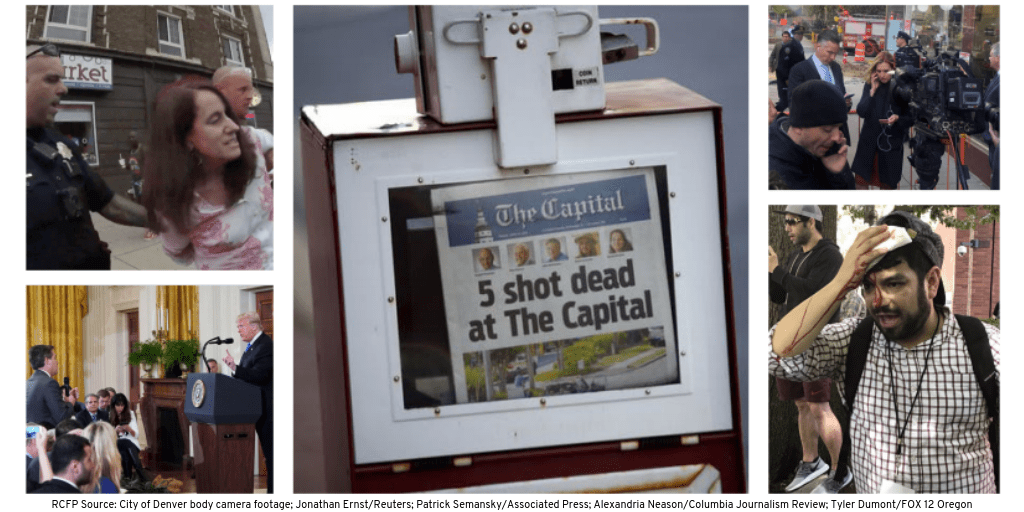5 takeaways from the Reporters Committee’s analysis of press freedom threats in 2018

Second annual survey of U.S. Press Freedom Tracker data indicates a troubling escalation in the level of violence aimed at journalists and government actions threatening press freedoms
U.S. journalists and news organizations faced an unprecedented level of attack from politicians and the public alike last year, according to a new report released on World Press Freedom Day by the Reporters Committee for Freedom of the Press in its second annual survey of data from the U.S. Press Freedom Tracker.
More than two dozen press freedom groups, including the Reporters Committee, launched the tracker in 2017 to provide “constant vigilance and an honest accounting” of press freedom in the U.S.
The full report is available here, but key findings include:
1. Violence against journalists has escalated against a backdrop of sustained anti-media rhetoric from the president and others.
Journalists in the U.S. continued to find themselves the targets of a dismaying number of physical attacks — 35 attacks affecting 42 journalists — ranging from assaults on reporters in the field to explosive devices mailed to CNN’s offices. Unlike in 2017, where the majority of assaults occurred at protests, in 2018, only about one-third of attacks occurred at demonstrations, most of which were at the hands of law enforcement.
Tragically, the tracker also had to add a new category in 2018 — killings of journalists — after a man shot several people in the Capital Gazette’s newsroom in June 2018, killing four reporters and a sales assistant.
2. The number of “leak” prosecutions and reported subpoenas grew.
The Justice Department acted upon its promise in 2017 to crack down on the disclosure of government information to the media, bringing charges against four federal employees in 2018, versus one in 2017, and securing dramatically harsher prison sentences than in earlier cases.
The number of subpoenas reported to the tracker for a journalist’s records or testimony also increased from six in 2017 to 26 in 2018. Although this category is particularly difficult to monitor and under-reported, since most subpoenas do not receive press attention, these numbers are nevertheless concerning. Most troubling was that, in two cases, federal agencies sought information from journalists — New York Times reporter Ali Watkins and law journal editor Daniel Kowalski — in an effort to identify their sources.
3. Typically-rare prior restraint cases were also more common in 2018.
There were five instances reported to the tracker where courts prohibited journalists and news outlets from publishing information in their possession — a significant increase from just one reported instance in 2017. While courts eventually struck down each of these prior restraints after further review, the rise in efforts to prevent the news media from publishing is concerning.
4. Efforts to deny journalists access persist.
The tracker also highlighted several instances where journalists were denied access to government events. In the most high-profile incident, the White House press office revoked CNN chief White House correspondent Jim Acosta’s press pass after he attempted to ask a follow-up question of Trump during a heated exchange at a news conference. Acosta and CNN sued to get his pass back and won.
5. The good news in 2018 was that there were fewer arrests of journalists.
Only 11 compared to 34 in 2017, perhaps because fewer demonstrations with mass arrests occurred. But protests were again the most common place of arrest, although covering court proceedings and law enforcement activities also led to some arrests.
The 122 incidents logged by the tracker in 2018 make clear that while the First Amendment has served as a powerful model for free speech and free press protections abroad, the U.S. news media has experienced increasing hostility in recent years, stoked by virulent attacks from politicians. Public concern is growing that what began as verbal attacks against members of the media by the president may have shifted to more concrete attacks on press freedom using the powers of the executive branch.
Taken together, these incidents demonstrate that even in light of the broad legal protections for press freedom under the First Amendment, it is imperative that the American public and policymakers denounce attacks that are designed to undermine a free press in this country.